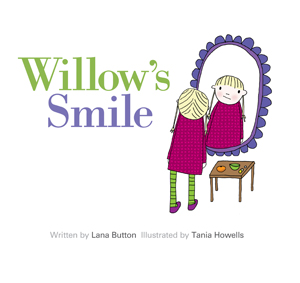| ________________
CM . . .
. Volume XXII Number 35. . . .May 13, 2016
excerpt:
Willow is the same school girl that she was in her earlier stories, Willow’s Whispers and Willow Finds a Way, although she is now growing up. In her first story, she could hardly speak while in her second story she found a way to include everyone. In Willow’s Smile, she is worried that she will not be able to smile appropriately for her school picture. Lana Button has used straightforward language to capture the difficulty that Willow has with producing a smile on demand. Willow worries that she will not dress properly. Even more, she worries that she will not create a perfect smile for the camera. She believes that her classmates are all confident and that they will be able to perform at the photo session. When she arrives at the gym for the picture, her worst fears are realized when her smile is gone for good. With the help of her teacher, the photographer and her classmates, Willow is able to overcome her difficulties and smile in her own way. Willow is a sensitive and observant child who is kind to everyone. She has an active, and likely typical, inner life full of fears and worries. She also sticks with a problem until she finds a good solution and is more than happy to share this with others. Both her teacher and the photographer notice that she is worried and help her to find her way. Willow’s Smile is a gentle and inclusive story that is centred in familiar locations. Setting the story around a class picture day makes it approachable to many children and provides not only a solution to this problem but also a way to approach problems in general. The illustrations by Tania Howells are simply and lovingly rendered to make each character unique and approachable. The colours are vivid and appealing, making the illustrations a charming part of the story. The relationships between the children are obvious as is the care that Willow shows to Tianna when she offers her a ribbon to wear in her hair. Any child will find a character to identify with in this classroom. In many of the illustrations, the background is white causing each child to appear separate; however, in a few images the children are shown in a coloured area indicating that the group is sitting together during class. Willow’s home is shown in more detail implying her connection to this area of her life. Many children have doubts and fears that they cannot express to the adults around them. Willow can provide an access point for this type of feeling. By being provided with a starting point, a child may see a way forward and start learning to act in the world while keeping a separate inner dialogue. Willow’s Smile will make a wonderful addition to the library of any child. Highly Recommended. Willow Moonbeam, a librarian living in Toronto, ON, has a wide variety of everchanging interests which always include knitting, astrology and learning new things.
To comment on this title or this review, send mail to cm@umanitoba.ca.
Copyright © the Manitoba Library Association. Reproduction for personal use is permitted only if this copyright notice is maintained. Any
other reproduction is prohibited without permission.
CM Home |
Next Review |
Table of Contents for This Issue -May 13, 2016
| Back Issues | Search | CM Archive
| Profiles Archive |
